

How to Grow The Top 10 Most Nutritious Vegetables in Your Garden. By Colleen Vanderlinden Treehugger A perfectly ripe, juicy tomato, still warm from the sun.

Sweet carrots, pulled from the garden minutes (or even seconds!) Before they’re eaten. Growing your own vegetables is one of those activities that balances practicality and indulgence. And don’t let the lack of a yard stop you – all of them can be grown in containers as well. 1. 6 Perennial Vegetables Produce Year After Year. Traditional backyard gardens tend to be full of annual vegetables that need to be started year after year from seed, and while those veggies can be well worth the time and labor it takes to grow them, planting some perennial vegetables in your garden and yard can end up putting food on your plate for far less effort.

Unless you live in a region with a year-round growing season, your tomatoes and peppers (which are perennial by nature) will need to be planted anew each spring, because they can't handle the cold temperatures of winter, but there are other vegetables that can overwinter in many places and spring back to life as soon as soil temperatures are warm enough. By dedicating a garden bed or two to perennial vegetables, especially in a polyculture with other perennials, you can pack a lot of food production into a small area. 6 Perennial vegetables that keep on giving, year after year: 1. 2. 3. 4. 5. 6 Easy Spring Vegetables You Can Start Now. While many standard garden vegetables can not be planted outside or started from seed until the soil is fully warmed and the threat of frost is past, a variety of other cool season spring crops can be started right now, giving you a jump start on the gardening season and putting food on your plate long before the summer vegetables come in.
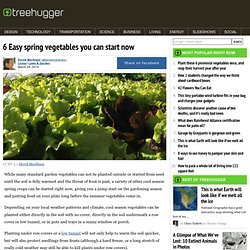
Depending on your local weather patterns and climate, cool season vegetables can be planted either directly in the soil with no cover, directly in the soil underneath a row cover or low tunnel, or in pots and trays in a sunny window or porch. Planting under row covers or a low tunnel will not only help to warm the soil quicker, but will also protect seedlings from frosts (although a hard freeze, or a long stretch of really cold weather may still be able to kill plants under row covers). 1. Spinach 2. 3. 4. 5. 6.
Snow peas, and other pod peas, are another great spring vegetable that kids tend to love. 4 Ways to Grow Spinach. Edit Article Choosing a VarietyPrepping Your Planting AreaPlanting Your SpinachCaring for Your Spinach Plants Edited by Flickety, Eric, Nathan Wong, Scott Cushman and 2 others A cool-weather loving green, spinach is a fast-growing relative of beets and Swiss chard.
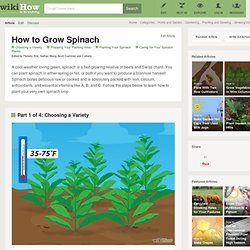
Growing Your Own Garlic. As far as I'm concerned, garlic gets the blue ribbon for growing your own.

It's absurdly easy to plant and care for; it tastes great; it looks beautiful and it takes up so little ground that even those with very small gardens can raise enough to be self-sufficient in garlic for a good part of the year. All you have to do is choose the right varieties; plant at the right time, in the right soil; then harvest when just right and store correctly. 1. Choosing Types of Garlic If you look in a specialist catalog like the one at Gourmet Garlic Gardens, you'll find dozens of varieties of garlic listed. You see where this is going – and you can see a lot more types of garlic on either of those websites, but for general purposes the most important difference is the one between softneck and hardneck.
Softnecks are so called because the whole green plant dies down to pliancy, leaving nothing but the bulb and flexible stems that are easy to braid. Gardeners in most of the U.S. can try some of both. How To Grow Favas, The Cool-Season Bean. August 6th, 2008 Email 19 users recommend Lumpy pods mean harvest time.
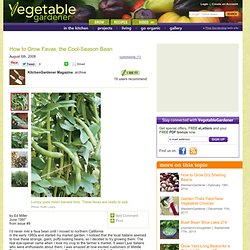
These favas are ready to pick. Ruth Lively. Bicycle Wheel Bean Tower. I've seen — and wanted — a goodly number of different commercial bean towers over the course of my gardening years.

However, I've never been quite willing to buy one of the things. After all, I've always figured it to be a pretty safe bet that sooner or later I'd come across a piece of somebody else's "junk" that'd do the job just as well and allow me to save a sizable sum of money in the bargain! Sure enough, last winter an obliging neighbor discarded a slightly bent bicycle wheel from his ten speed. How To Grow Green Beans, Even With A Brown Thumb. Whether you call them string beans, snap beans, or haricots verts, green beans are a great addition to any backyard garden, and because they're easy to grow and harvest, they can be a good gateway crop for beginning gardeners.
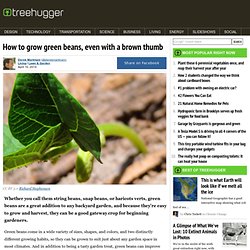
Green beans come in a wide variety of sizes, shapes, and colors, and two distinctly different growing habits, so they can be grown to suit just about any garden space in most climates. No Dig Potatoes.mp4. Growing Potatoes In Straw. Forget about what you think you know about growing potatoes...

Are you ready for something new? We are...so we decided to plant our potatoes in straw this year. It's sooo simple. No digging. No weeding. So simple a child can do it (and she did). How To Plant Cuttings Of Potatoes. Overview Potatoes are starchy, tasty root vegetables that are easy to start from cuttings of other potatoes.
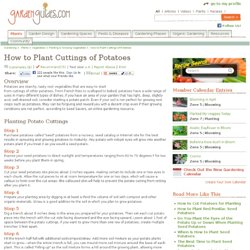
Homestead Series: Making Row Spacers. Homestead Series: How To Plant Potatoes, Start To Finish. Homestead Series Building A Potato Hiller. All About Tomatoes. May 19th, 2010 Email 72 users recommend Photo: Danielle Sherry Tomatoes are the favorite food crop of America's home gardeners. If you need information on selecting tomato varieties or on growing, pruning, and trellising your plants, and protecting them from pests, you've come to the right place. I like my greens and beans, but tomatoes are at the top of my gardening food pyramid. For an entertaining video overview of planting, pruning, staking, preserving, and cooking with tomatoes, watch Homegrown/Homemade: Tomatoes. Everything Tomato For People Who Love Tomatoes. How To Grow Tomatoes From Fresh Tomato Seeds.
5 Best Carrot Growing Tips. December 17th, 2013 Email 2 users recommend Phot by ccharmon under the Creative Commons Attribution License 2.0. Photo by WordRidden under the Creative Commons Attribution License 2.0. One of my favorite gardening memories is the morning that my 3-year-old son wrapped his little hands around some greens in our garden and tugged. That cool, spring morning when the orange root slid out of the ground, he held it up like a prize and said "Look! Carrot Growing Tip #1 -- Looking back, my son most likely forgot what we had even planted as carrot seeds seem to take forever to germinate (sometimes 15-17 days). I'm not buying it. For some reason they germinate much later than any other vegetable I've ever grown. Anyway, whether I plant them in late summer for a fall/early winter harvest or late winter for a spring one, my carrots have zero sense of urgency and seem to lollygag along.
(I do realize having said that, someone will comment that their carrots shoot up with lightening speed. Shady Veg. Garden. Most people envision their gardens as being in full sun all day long, and yet there may be some of us that have more shade in our yards than full sunshine. Is it still possible to have a vegetable garden? I say yes, you can!
You may not be able to have all of your favorites, but then again you may be able to grow plants that others cannot. Then you can barter with those in your community that need what you have grown for what you are not able to raise in your own garden – see my article “Bartering.” So what can you grow in a shady garden? There are plants that hate shade: tomatoes, peppers, cucumbers, and all varieties of squash. If your garden area is only partially shady during the daylight hours, there are plants that will work well for you. I think that all homegrown vegetables taste much better than their store bought relatives. Help your garden out by knowing what it needs. Enjoy the fruits of God’s blessing and your labors!